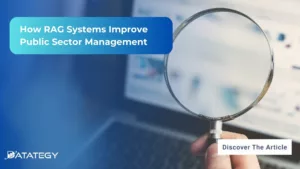How Law Firms Use RAG to Boost Legal Research RAG...
Read MorePredicting future sales using previous data is one of AI and machine learning’s most obvious uses. Historical data provides you with an accurate and realistic view of the amount of money your team should be producing over a specific time period. According to a study by Salesforce, 62% of high-performing sales teams are currently using AI to improve their sales forecasting accuracy.
Find out how papAI can improve the deployment of AI projects in the sales sector here.
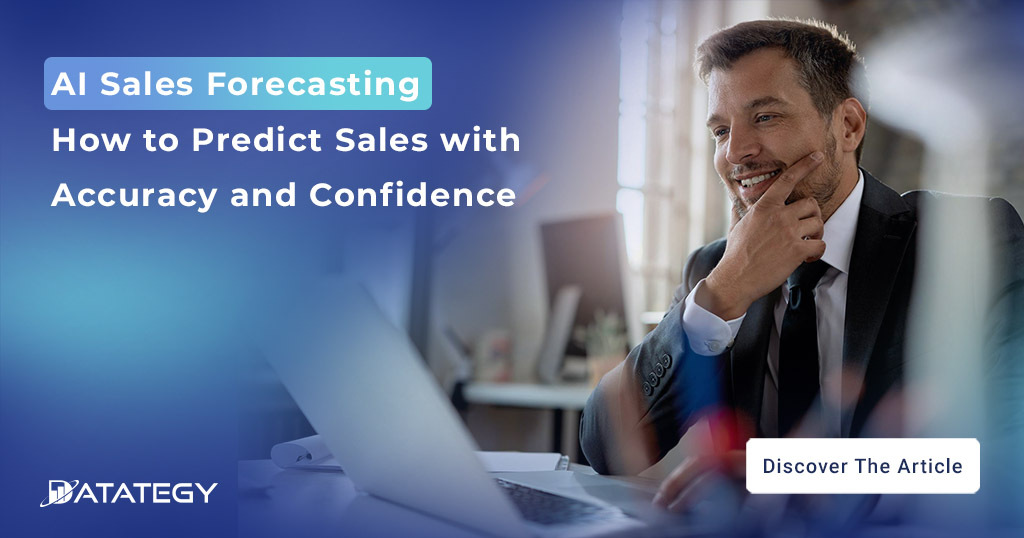
Advanced algorithms, machine learning methods, and historical data are used in AI-powered sales forecasting models to find patterns, trends, and correlations that can help predict future sales. The advantages of AI sales forecasting, the essential elements of a powerful AI sales forecasting model, and best practices for integrating AI into your sales forecasting process are covered in this article.
What is Sales Forecasting?
Sales forecasting is the process of estimating the volume of sales and ensuing revenue over the course of a future time period using knowledge, historical data, sales activity data, and predictive analytics technology. Every successful sales team, and almost all sales teams, has a system for predicting sales.
An excellent sales forecast does not rely on guesses but rather analyses real-world facts to determine what outcomes are likely. Sales forecasting is crucial because it may inform resource allocation and employment decisions, financial estimates, risk management, and other processes.
What is the Importance of Accurate Sales Predictions?
Accurate sales forecasts are essential for driving success in any business environment, as they enable companies to make data-driven decisions that improve overall sales performance. By leveraging sales forecasting software powered by machine learning and artificial intelligence, businesses can accurately forecast future sales and gain valuable insights into customer behavior, market conditions, and historical sales trends.
Analyzing historical data helps businesses predict future sales with greater forecasting accuracy, allowing them to fine-tune their sales strategies, allocate resources effectively, and respond proactively to shifting demands. This leads to optimized inventory management, better budget allocation, and a strategic approach that benefits both the sales team and sales reps on the ground.
When companies accurately forecast using historical sales and real-time data, they enhance their ability to make informed choices that align with their goals. Sales forecasting software empowers teams to analyze historical sales data and extract patterns, allowing them to create accurate predictions that account for market conditions and seasonal trends.
This improves not only the confidence of sales teams in their approach but also helps leadership develop sales strategies that are more resilient and adaptive. With accurate sales forecasts, businesses can anticipate potential challenges and seize opportunities, ensuring that the sales team operates efficiently and remains focused on achieving sustainable growth
Great Forecasts Need Good Data
The accuracy of forecasting has grown critically dependent on the quality of the data as firms depend more and more on data-driven decision-making. Great predictions are built on solid data, which offers insights into market trends, consumer behavior, and other elements that affect sales success.
Making accurate projections that allow firms to deploy resources efficiently, plan for the future, and optimize revenue requires good data. Companies may make confident data-driven decisions by identifying patterns, trends, and correlations in their data and using this information to influence sales estimates.
Despite the benefits of good data, businesses often face challenges in obtaining and managing high-quality data for forecasting. According to a report by Experian, 83% of companies faced data quality issues in 2019, among these challenges:
– Data quality issues: When there are mistakes, exclusions, or inconsistencies in the data, it can be challenging to make reliable inferences and predictions.
– Data accessibility: Data may be kept in several places or in various forms, making it challenging to utilise for forecasting.
– Data integration is challenging because different data sources may utilise various data formats or different types of data, making it challenging to combine and evaluate the data.
– Data privacy and security: Organizations must abide by data privacy laws and protect the security of their data, which can make data collecting and administration more difficult.
Benefits of AI sales forecasting
1-Improved Reliability and Accuracy
In order to provide extremely precise forecasts of future sales, AI sales forecasting models may examine huge volumes of data, including historical sales data, market trends, and consumer behavior. With conventional forecasting techniques, which frequently rely on small data sets and subjective assessments, this degree of precision is just not achievable. With AI, businesses can depend on data-driven insights to lower guessing and boost prediction accuracy and reliability. According to a report by Aberdeen Group, companies that use AI for sales forecasting have an average forecast accuracy of 79%, compared to 51% for those that don’t.
2-Real-time Insights and Adaptability
Conventional sales forecasting techniques sometimes depend on outmoded historical data and presumptions about the state of the industry. On the other hand, AI sales forecasting algorithms can instantly adjust to shifting market conditions, giving businesses the most recent information and advice. This increases firms’ chances of success by enabling rapid and efficient strategy adjustments in response to fresh information.
3-Improved Efficiency and Time Savings
Sales teams will have more time to devote to more important duties because to AI sales forecasting models’ ability to evaluate enormous volumes of data considerably more quickly than humans. As a consequence of more effective resource allocation and decreased waste, companies may also see cost savings as a result of this enhanced efficiency.
4-Increased Revenue and Profitability
AI sales forecasting may help companies in defining goals and allocating resources by giving precise and timely insights into upcoming sales. Due to the capacity to concentrate efforts on high-potential areas and prevent resource wastage, this can ultimately boost revenue and profitability for businesses.
According to a survey by Accenture, companies that use AI in sales forecasting reported an average revenue increase of 6.1% and a profit increase of 5.6%. Additionally, the same survey found that 81% of companies that used AI in sales forecasting reported an improvement in their sales and revenue forecasting accuracy
Types of AI models for AI Sales Forecasting
Time Series Forecasting
In order to predict future trends and performance, Time Series Forecasting, a fundamental technique in AI-driven sales forecasting, mainly depends on examining historical sales data. This method entails monitoring and analysing data points over time in order to spot trends, whether they be seasonal, weekly, monthly, or daily. Time series forecasting can identify recurring patterns and irregularities in sales data by utilising advanced AI algorithms like recurrent neural networks, exponential smoothing, and ARIMA (AutoRegressive Integrated Moving Average). The end product is a prediction model that helps companies make better plans by accurately predicting seasonality and changes in demand.
Regression Analysis
Another effective technique in AI sales forecasting is regression analysis, which looks at the ways in which different factors affect sales results. This method uses statistical models to examine the connections between one or more independent variables, like pricing, demographic data, marketing campaigns, and even outside variables like the weather, and a dependent variable, usually sales data. Businesses can determine the factors influencing their sales performance and make data-driven decisions to maximize marketing campaigns, pricing schemes, and resource allocation by comprehending these relationships.
Ensemble Learning
Using predictions from several models, ensemble learning is an advanced AI technique that generates a single, more accurate forecast. In order to produce results that are frequently more dependable than those produced by individual models, this method makes use of the advantages of multiple algorithms, each of which offers distinct insights. Boosting (e.g., Gradient Boosted Trees) and bagging (e.g., Random Forest) are common ensemble learning techniques that increase the overall robustness of sales forecasting.
Clustering
In AI-driven sales forecasting, clustering is a data analysis technique that divides data into groups or clusters according to shared traits. This method looks for trends among clients, goods, or sales areas using algorithms like k-means or hierarchical clustering. Clustering can provide information about consumer behaviour, buying patterns, and product performance by examining historical data.
What is the advantage of Time series forecasting?
Time series forecasting is a data analysis method for making future value predictions based on past data. In order to create predictions, univariate time series forecasting focuses on tracking a single variable through time. Comparatively, multivariate time series forecasting analyses several factors at once to produce predictions.
With the help of several tools and frameworks like Statsmodels, Prophet, and TensorFlow, Python programmers may forecast time series utilizing both univariate and multivariate variables. Simple models like ARIMA (AutoRegressive Integrated Moving Average) or sophisticated models like LSTM (Long Short-Term Memory) can both be used for univariate time series forecasting. Multivariate time series forecasting calls for more sophisticated models, such as VAR (Vector Autoregression) and VARMAX (Vector Autoregression Moving-Average with eXogenous inputs), that can handle numerous variables and their interactions.
Depending on the data at hand, the issue being handled, and the level of precision sought, one may choose between univariate and multivariate time series forecasting. Although univariate forecasting is quicker and easier, it could not account for all the variables that affect the forecasted variable. By taking into account several factors and their interactions, multivariate forecasting is more complicated but can produce forecasts that are more accurate.
AI and Machine Learning for Sales: The Key to Unlocking Growth Potential
The development of artificial intelligence (AI) has significantly changed the sales industry, which has witnessed a remarkable evolution throughout time. The way companies approach sales processes and strategies has been completely transformed by AI. In this white paper, we will examine the concept of AI in sales, its historical evolution, and the advantages it provides for companies.

Use case:
Predict Car Sales using TSForecasting models on papAI Solution
Context
In this use case, we will see how papAI solution can be used to predict the number of cars each car dealer needs and therefore predict the number of cars sold.
1- Data set
We will use a database that exists in open data. This database contains 79 weeks of daily data and includes the number of car orders placed by individuals.
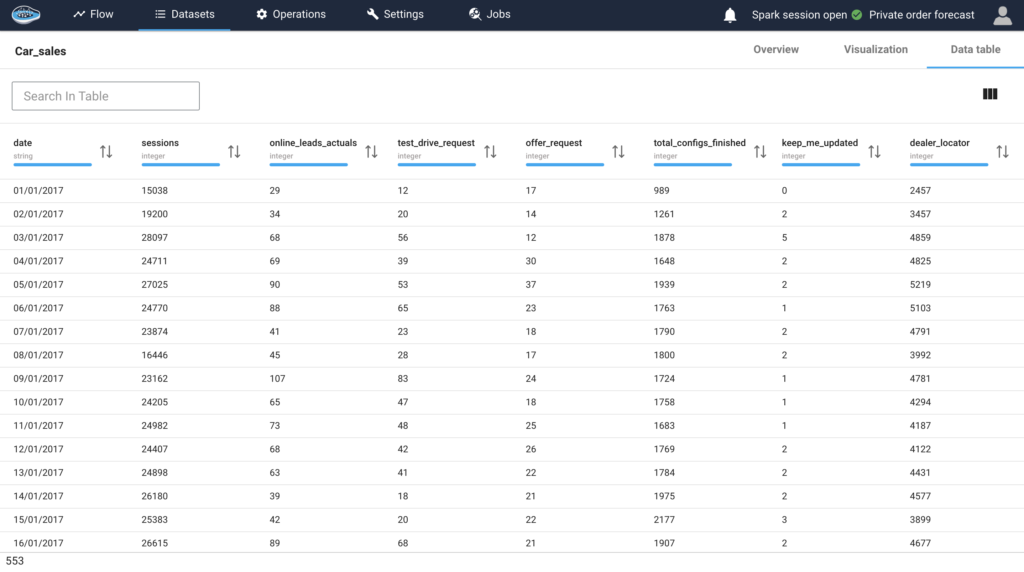
As we can see in the first few rows of the dataset above, the dataset has 8 columns which are as follows:
- Date : Datetime (DD/MM/YYYY)
- Sessions : Number of website visits on a specific day
- Online_leads_actuals : Number of visits to online shop (order online)
- Test_drive_request : Number of test drive requested
- Offer_request : Number of offers requested
- Total_configs_finished : Number of car configuration completed
- Keep_me_updated : Number of users asked to be kept updated
- Dealer_locator : Number of users who looked for a dealer location
- Private_orders : Number of times a private order has been made. This represents the total number of offline sales received. We should try to predict this field.
2- Data preparation
papAI solution allows to perform general processing operations, which allows the processing and preparation of data, without having to manipulate lines of code. If you want to do processing on a time series database, then a separate module is dedicated to this kind of data.
As you can see in the database (previous picture), the date column is of type ‘string’. This column contains dates, so the first thing to do in papAI is to use the general processing cleaning to convert the type of this column to the correct format ‘date’.
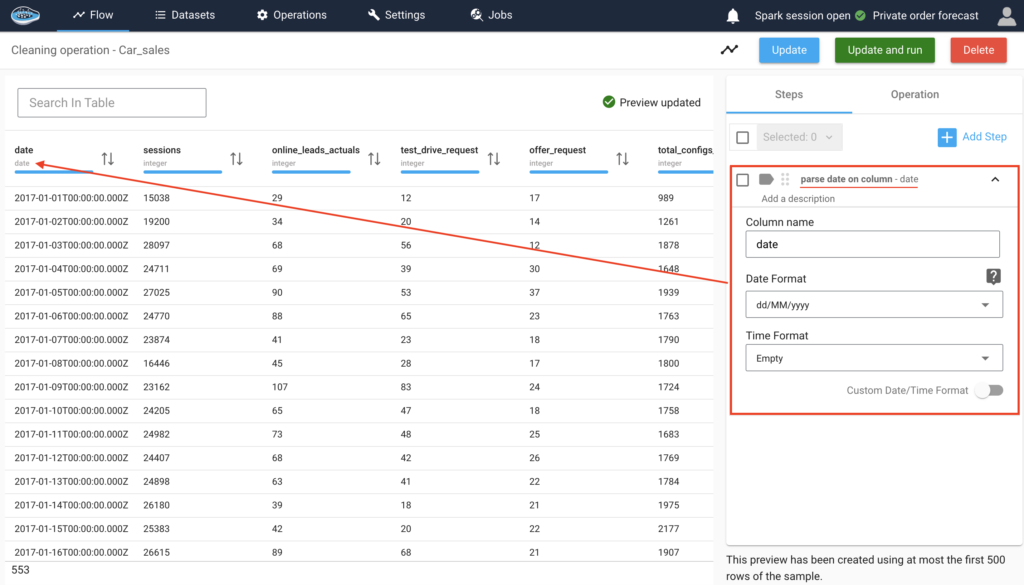
The second processing we will apply is the datetime feature generation which is in the TS Cleaning module of papAI Solution. This operation extracts additional information from the date such as: Day of year, Week of year, Day of week, Day of month ……etc . This allows us to have more features and it will allow us to have a better accuracy in the forecasting.
3-Machine Learning
Model training
papAI is a platform that allows to run of several machine learning models at the same time, without coding. These models are first displayed with the default settings of scikit learn, and these settings can be modified by the user if he wants. When creating a machine learning use case, papAI Solution offers us to choose between Single series ‘ Univariate ‘ or Multiple series ‘ Multivariate.
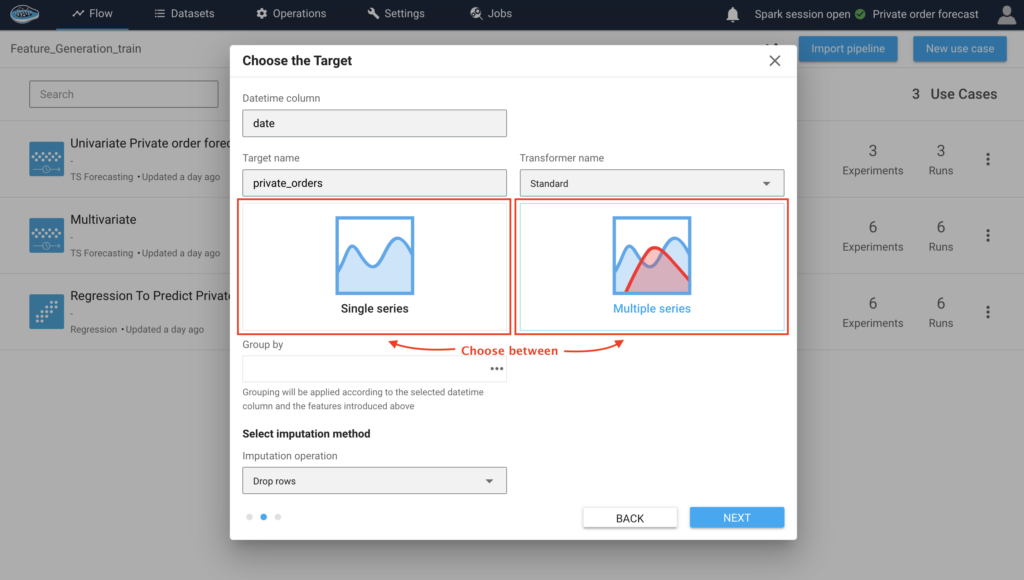
3.a) Univariate:
The TsForecasting univariate is to train a machine learning model by taking into account the target variable on the time series, so in this method, we will use only two columns of our dataset (Date and Private Order).
3.a.1) Data analysis:
After choosing Private Order as a target, and univariate as a series type, papAI automatically displays a visualization of the evolution of ‘Private order’ on the Temp.
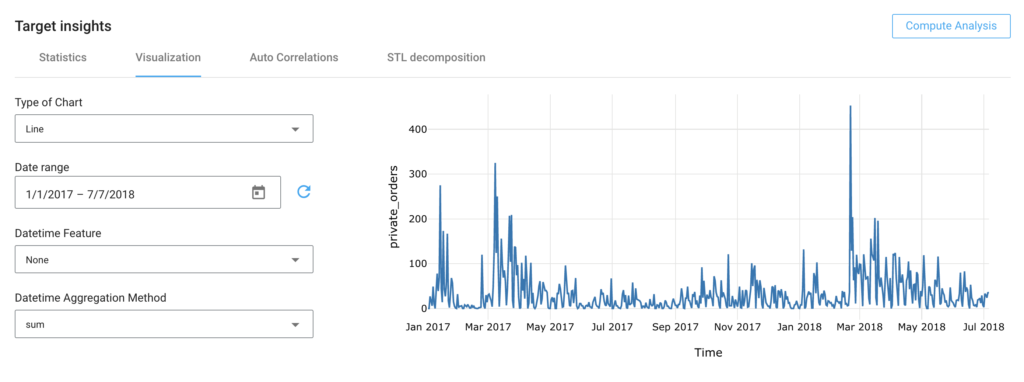
In the tab next to it, we can see an analysis of our database/
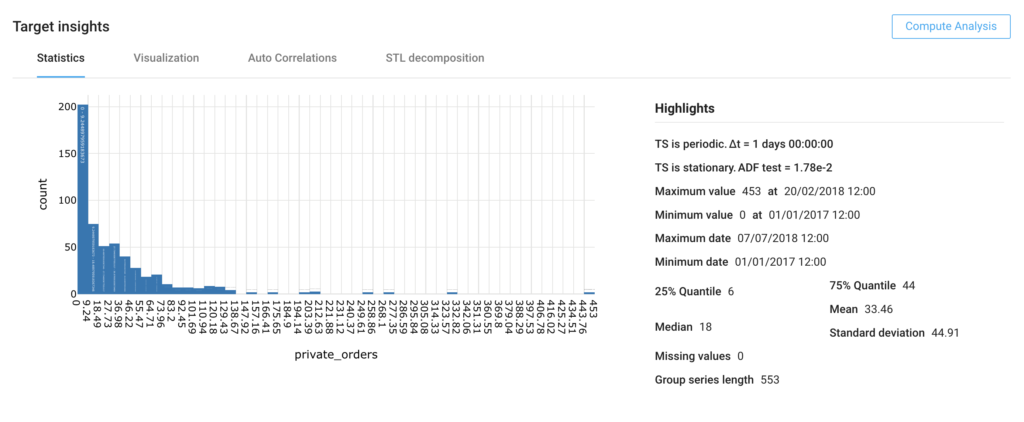
The statistics generated give us very useful information that could help us to become more familiar with our database.
The observations contain :
- The periodicity of the database is 1 day
- The data were collected between 01/01/2017 and 07/07/2018
- The minimum value was 0 on 01/01/2017
- The maximum value was 453 on 07/07/2018
- The Median was 18, the Mean was 33.46.
- No missing values.
- The size of the dataset is 553
3.a.2) Create Prototype :
When creating the univariate prototype we must first choose the ‘Data history to consider’, and the number of ‘Future values to forecast.
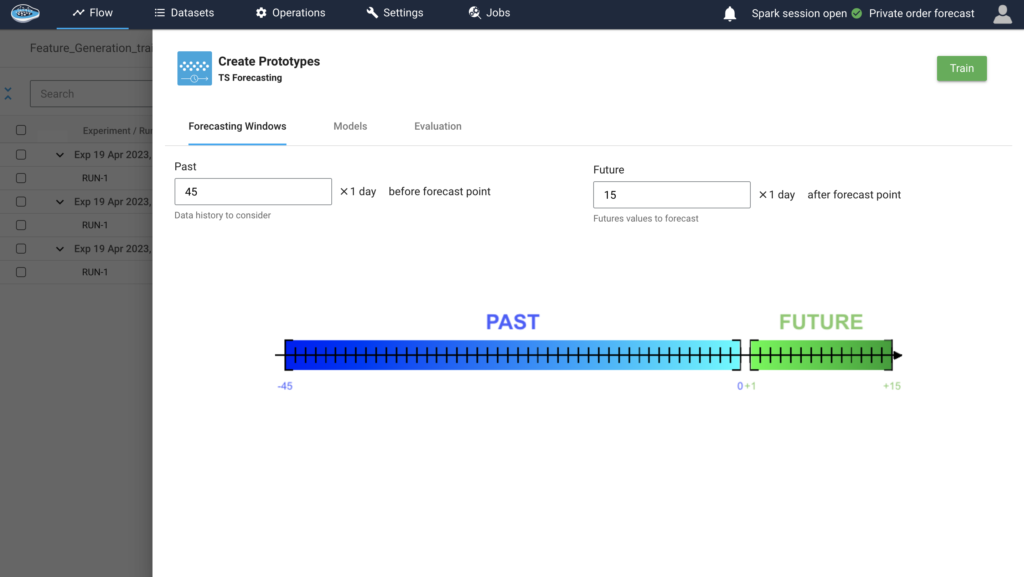
After defining the Forecasting windows, we have to choose the models we would like to train, in multivariate, there are 12 models which are the following
- ARIMA forecaster
- Block RNN
- LSTM
- GRU
- FFT
- LightGBM
- NBEATS
- Prophet
- Regular ML Models (Linear regression)
- Regular ML Models (Random Forest)
- SES
- TCN
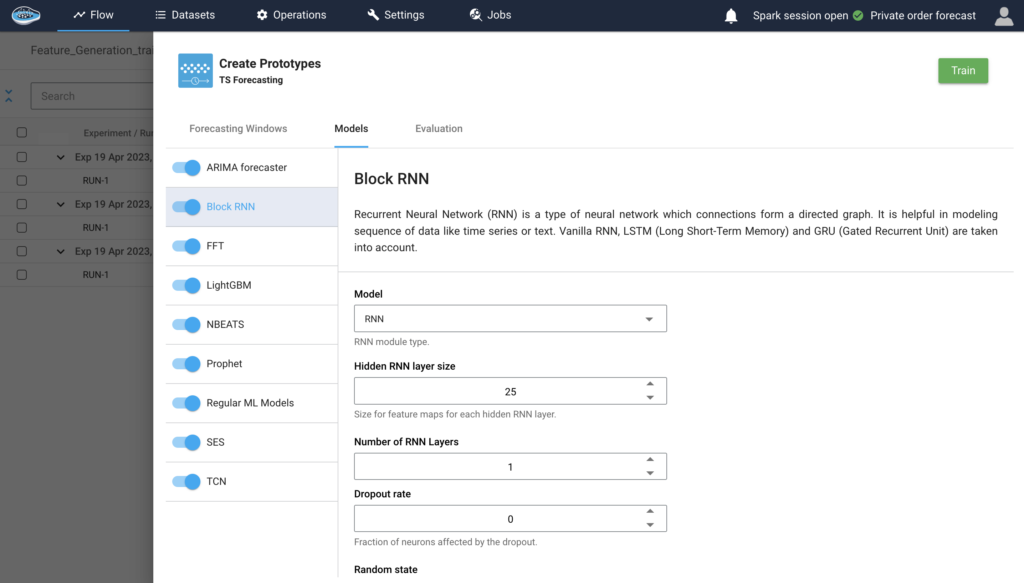
papAI solution guarantees an evaluation of each machine learning model. In order to set up the evaluation of our models.
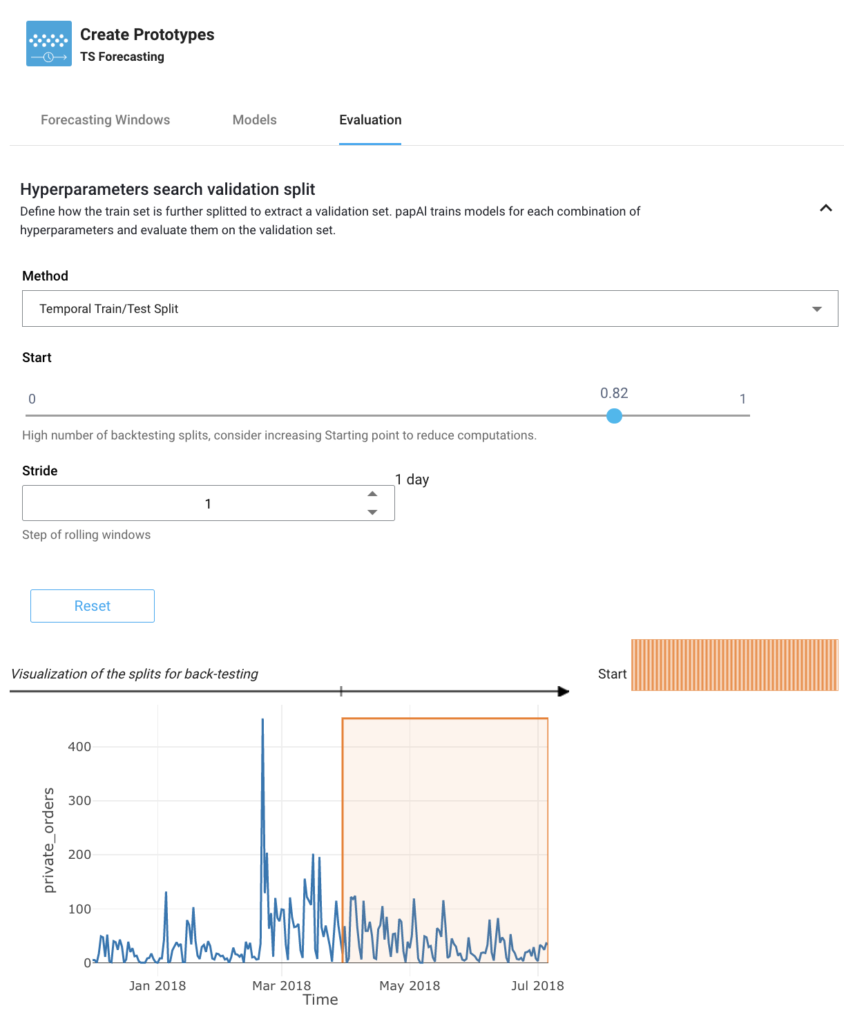
After starting the training, we get the evaluation of each model.
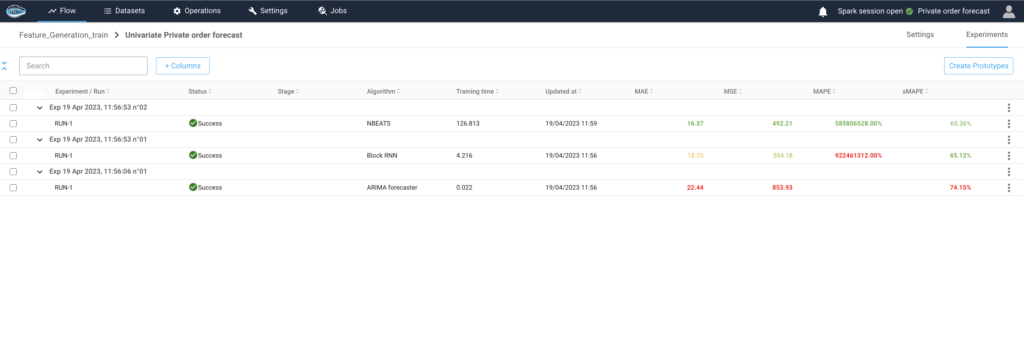
The best-evaluated model is the NBEATS.
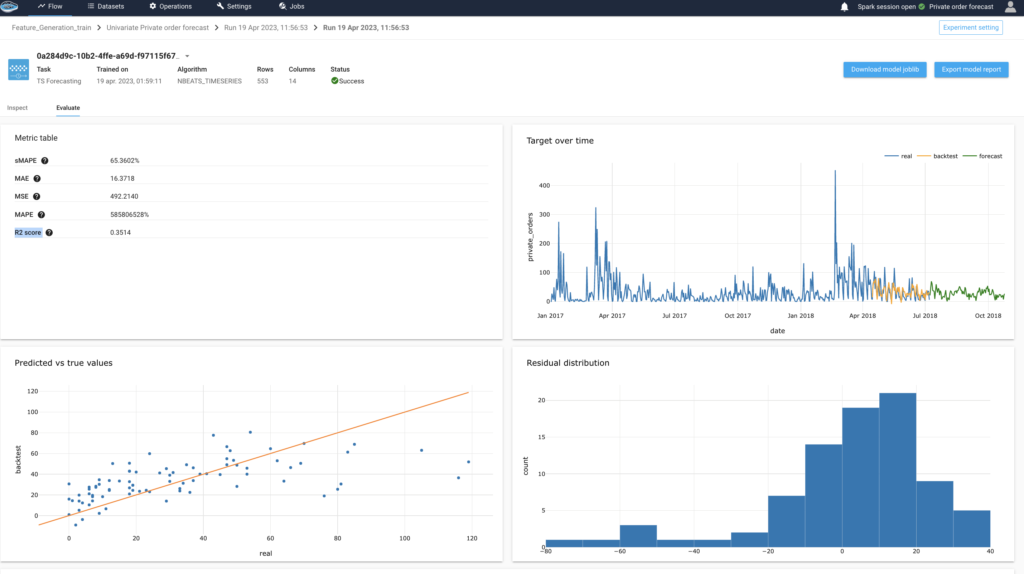
We can see in the evaluation which metrics have been taken into account:
- Metric table with the (sMAPE, MAE, MSE, MAPE, R2 score)
- Plot of the Target over time
- Plot of predicted value vs true value on a backtest
- Risidual distribution and risidual hilight
3.b) Multivariate:
When creating the Multivariate prototype we must first choose the features that can contribute to a better result.
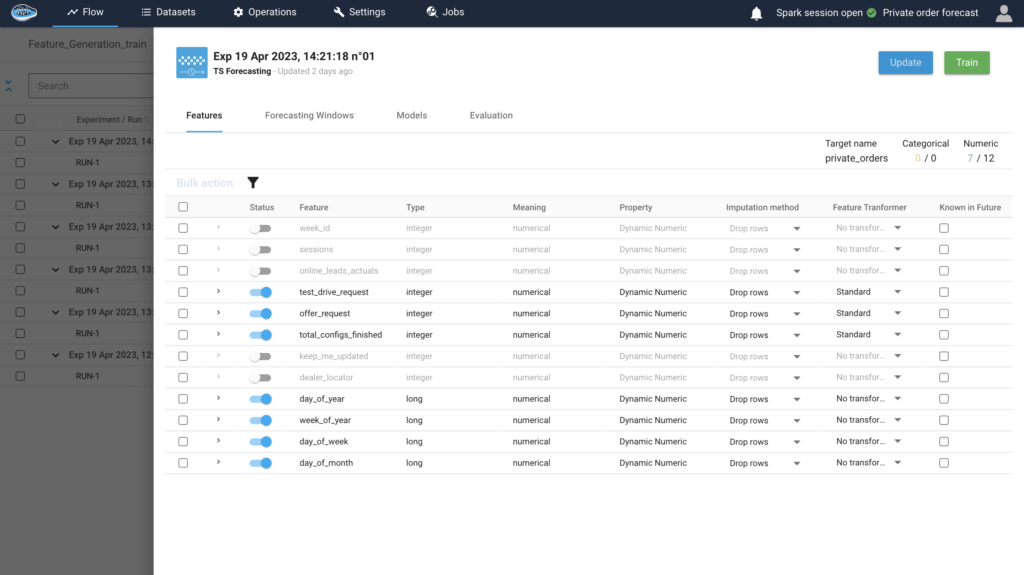
The second step would be to define the forecasting window with the number of points to be considered in the past and in the future.
The third step is to choose the models on which we would like to train the forecast.
In multivariate, papAI Solution has 16 models, which are the following
- Block RNN(RNN)
- Block RNN (LSTM)
- Block RNN (GRU)
- LightGBM
- NBEATS
- Regular ML Models ( Linear Regression)
- Regular ML Models ( Random Forest)
- TCN
- DeepAR (LSTM)
- DeepAR(GRU)
- Temporal Fusion Transformer
- MQ-CNN
- DeepState (LSTM)
- DeepState (GRU)
- DeepFactor (LSTM)
- DeepFactor(GRU)
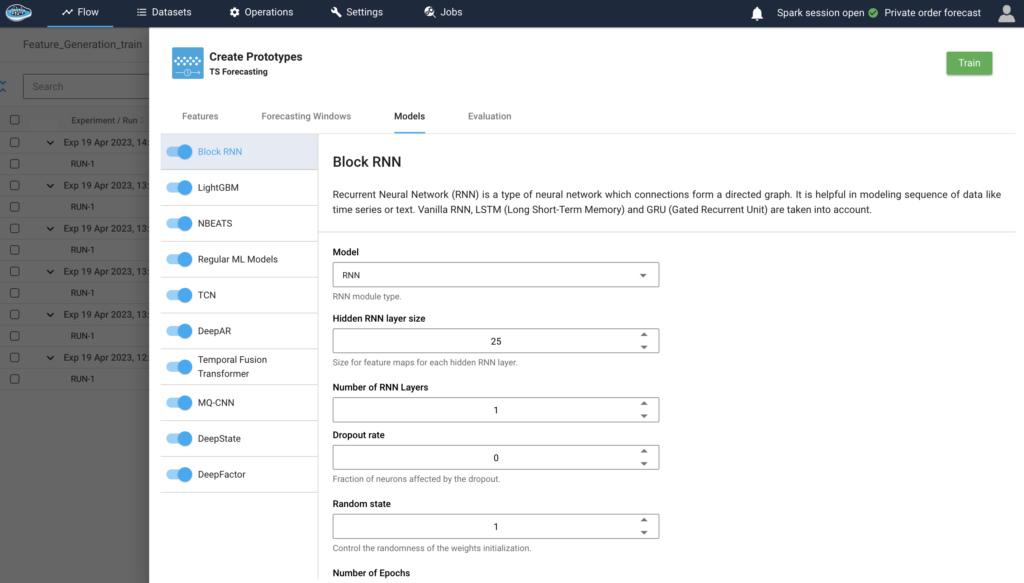
4- Prediction
After evaluating and comparing the models we ran, the NBEATS model gave the best results, we will predict the number of sales per day for the next 4 months with the NBEATS model (univariate).
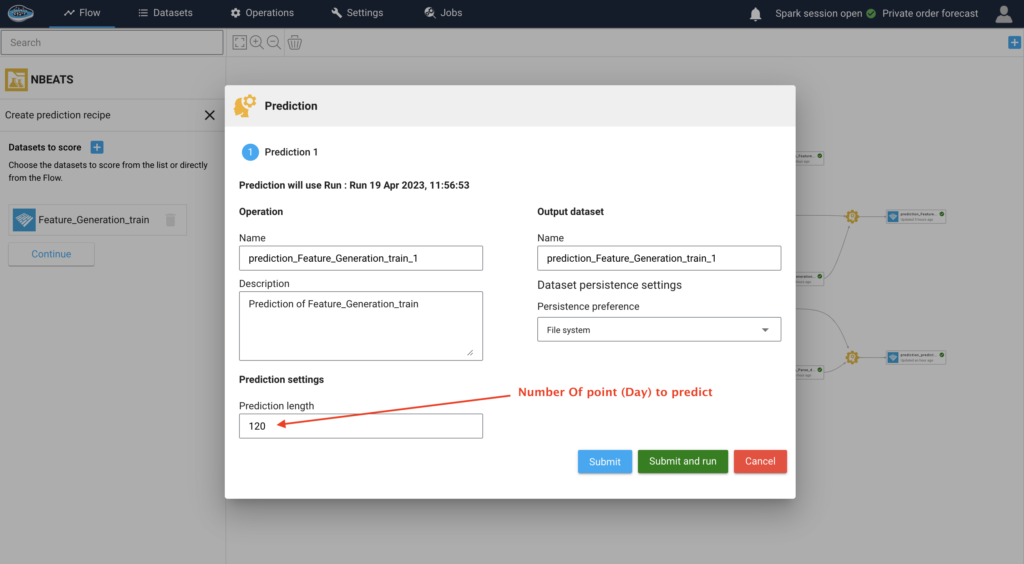
Viewing the results:
The result of the prediction is a data frame, with the values of the private order over the next 4 months following the last date of our dataset.
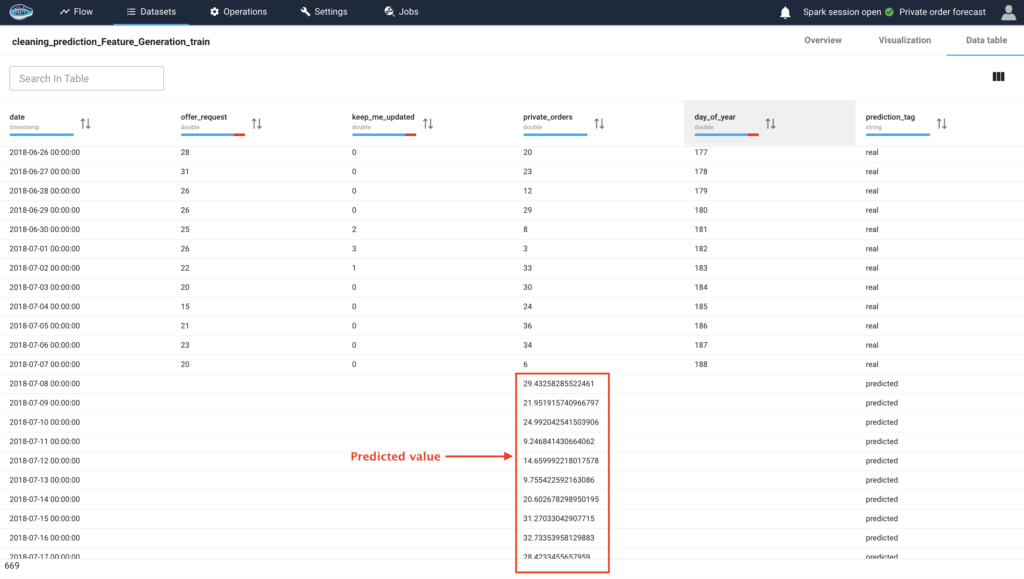
This visualization shows us the true values in blue, and the values that were predicted by our model between July 7, 2018 and November 09 of the same year.
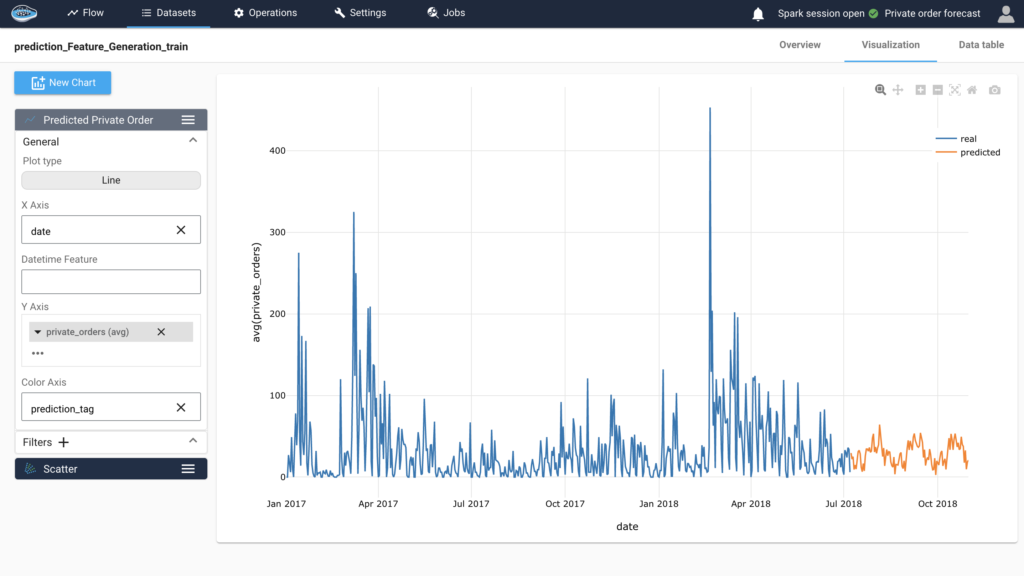
Create your own AI-based tool with papAI solution to improve the accuracy of your sales forecast
In conclusion, organizations of all sizes are finding that using AI-based technologies for sales forecasting is more necessary. Businesses may build their own AI-based tools that are uniquely suited to their needs with papAI solution. This might lead to more accurate and trustworthy sales estimates, which would enhance decision-making and boost profitability.
papAI solution helps to explain and make transparent the results through a process of data mining, cleaning, and visualization that can accelerate the deployment of AI projects and drug discovery and reduce the time and cost of bringing new therapies to market.
Book your demo now. Our team of experts can help you create a custom AI-based tool that meets the unique needs of your organization.
Interested in discovering papAI?
Our commercial team is at your disposal for any questions
How RAG Systems Improve Public Sector Management
How RAG Systems Improve Public Sector Management The most important...
Read MoreScaling RAG Systems in Financial Organizations
Scaling RAG Systems in Financial Organizations Artificial intelligence has emerged...
Read MoreHow AgenticAI is Transforming Sales and Marketing Strategies
How AgenticAI is Transforming Sales and Marketing Strategies Agentic AI...
Read More
